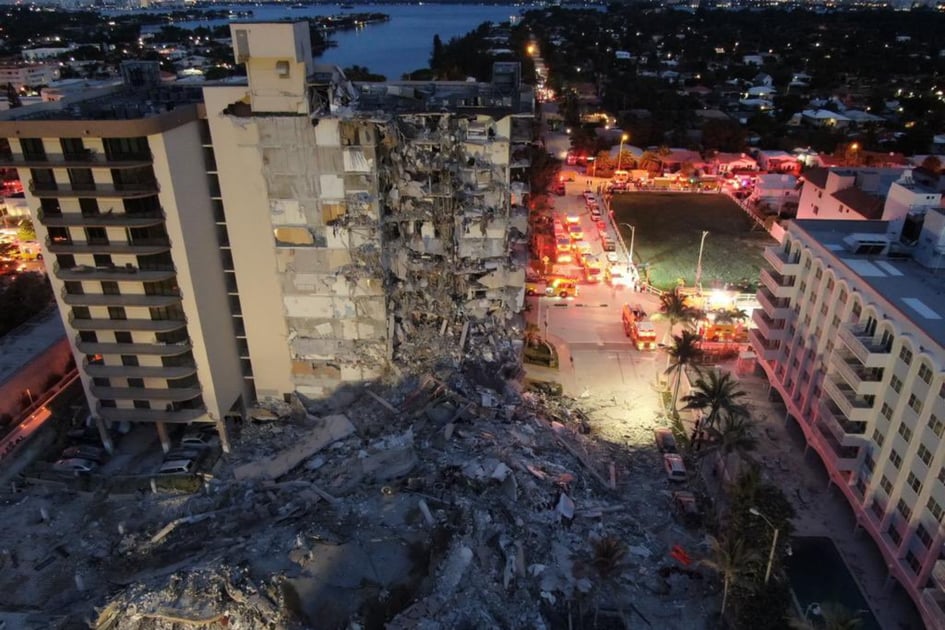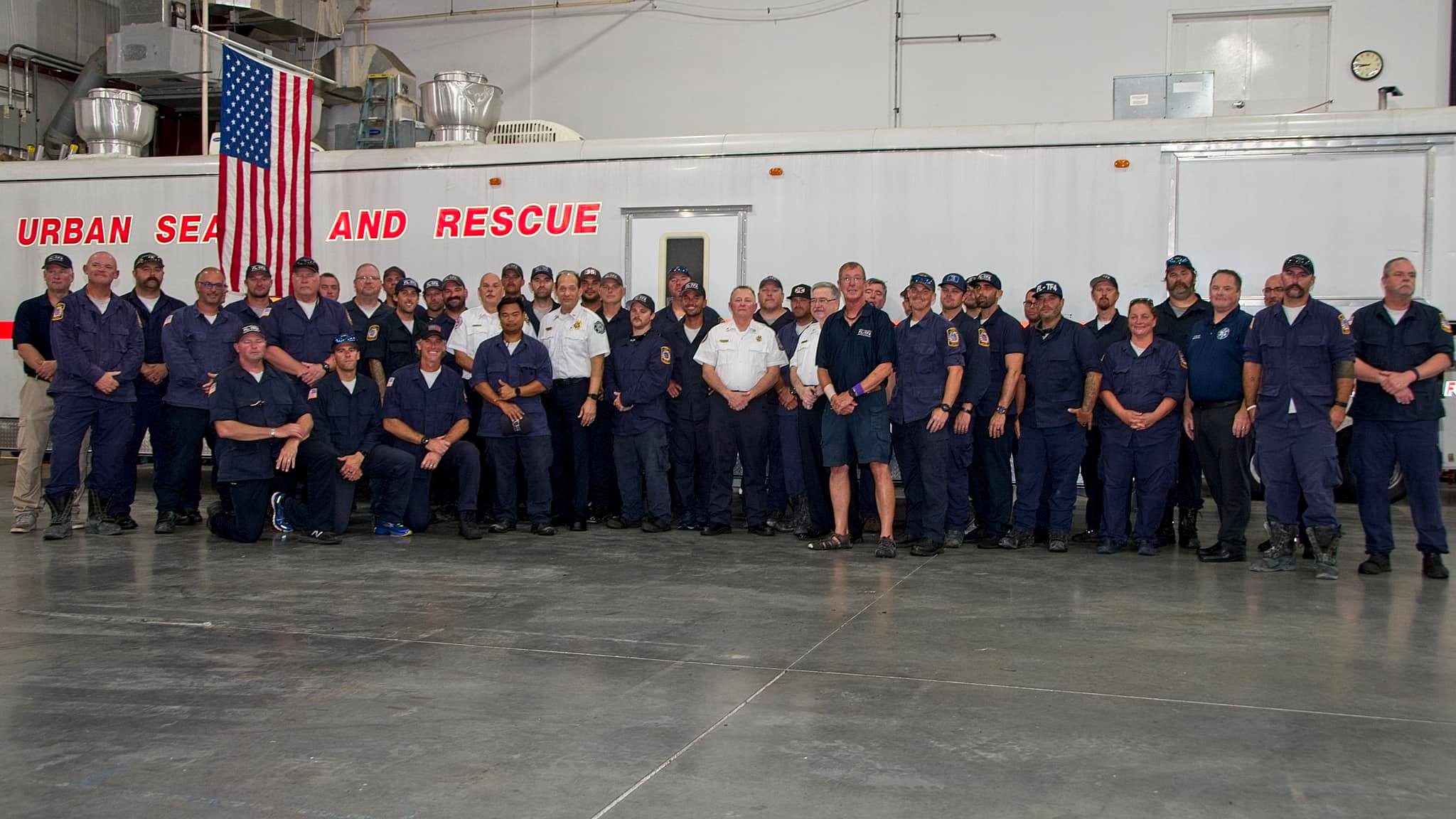Inside the aftermath of the Surfside collapse: An AMPP Member’s Story
June 21, 2022 •Corrosion CONTROLLED, Corrosion Management

Corrosion experts notice things most people miss. Whether it’s on a bridge, a ship, or a lamppost, a little rust may be overlooked, but a corrosion professional sees the cause or imminent damage of that rust. In a 3-part series in Materials Performance Magazine, Byron Evetts provides his perspective on the Champlain Towers South recovery effort and wreckage in the days after the devastating collapse.
Note: The article below includes excerpts from a 3-part series originally published in Materials Performance Magazine:
Part 1 • Part 2 • Part 3
A Corrosion Engineer and First Responder.png?width=329&name=Evetts%20(1).png) On June 24, 2021, Byron Evetts saw the footage of the Champlain Towers South collapse and prepared his rescue gear, knowing he would be called to help in Surfside, Florida. It would be his 27th deployment as part of the Federal Emergency Management Agency’s (FEMA) or State of Florida Urban Search & Rescue (US&R) disaster response task force.
On June 24, 2021, Byron Evetts saw the footage of the Champlain Towers South collapse and prepared his rescue gear, knowing he would be called to help in Surfside, Florida. It would be his 27th deployment as part of the Federal Emergency Management Agency’s (FEMA) or State of Florida Urban Search & Rescue (US&R) disaster response task force.
When Evetts began his career with a marine engineering firm, he quickly recognized that honing his corrosion knowledge and skills would open doors to more career opportunities. In 1981 he joined the National Association of Corrosion Engineers (NACE) — now known as AMPP, the Association for Materials Protection and Performance — where he worked his way through courses and exams to earn his Cathodic Protection Specialist and Protective Coating Specialist certifications. For the last 20 years, he has run his own company, Existing Structures Engineering.
His start with urban search and rescue came in 1996. “I was drafted as a ‘Structure Specialist,’ which means someone who’s completed advanced training and willing to go into very dangerous places to do building assessment, building triage, and building stabilization,” says Evetts.
“When I got the call in June, I immediately knew my US&R team was headed to what would become North America’s biggest accidental collapse in history.”
Each member of Evetts’ US&R team was a professional engineer— a few had fire department credentials, and another was a reserve law enforcement officer. “I’d just retired from my local volunteer fire department after 22 years. Between us, we each had one toe in emergency services.”
“Because of the nature of the disaster, we knew there would be only body recovery. Our primary job was to focus on the pile to make sure it didn’t shift horribly. And we also had to focus on the building next door because it was the same design, same construction, and the same age as Champlain Towers South, only now it was damaged.”

Urban Search and Rescue at Champlain Towers South
According to Evetts and several corrosion engineers interviewed by AMPP, typically a catastrophic failure like the one in Surfside would be the culmination of multiple failures, not a single cause. The National Institutes of Standards and Technology (NIST) is taking a meticulous approach to its years-long investigation of the Champlain Towers collapse.
In the meantime, surviving residents of the Champlain Towers, as well as the families of those lost in the collapse, are left with no answers; as are building owners, insurers, high-rise residents, and others looking to prevent another disaster like this. As the investigation continues, engineers, contractors, and others have studied photos and residents’ accounts, which would indicate that some sort of failure was inevitable.
Impressions of Possible Design Weaknesses
Although Evetts and his fellow US&R team members weren’t brought on site as forensic engineers, their engineering backgrounds make them naturally curious. They couldn’t help but look for answers in everything around them.
While working at the incident site, Evetts and many others shared concerns about things they noticed among the debris. “Some of the ‘rock breakers’ (Rescue Specialists) said the concrete was softer than training concrete…,” said Evetts. “We pour very weak concrete during training. They've all broken rocks in other buildings, and they felt like there was something wrong with the strength of the concrete. Add that to the fact that the building may have been under-designed, throw in corrosion, and you possibly have a formula for a catastrophic collapse.”
Preventable Disasters
Having worked in Florida and the Southeast for decades, Evetts notices vulnerabilities in structures all over the state and is concerned about the efficacy of local building inspections, which he and many other engineers consider to be insufficient.
Engineers have been puzzled by the 40-year inspection rule in Dade and Broward County. Throughout his career, Evetts’ work has covered territory extending from Hawaii to Aruba to Africa, and up and down the east coast of Florida. “We have not seen a single building in my service area that could go 40 years without undergoing its first major maintenance,” he said.
Since the Surfside tragedy, Evetts and other corrosion experts are most concerned about the lack of focus on corrosion control.
“It's almost criminal that we don't require more corrosion control measures such as the use of inhibitors in concrete, and in some cases the use of cathodic protection systems built into the concrete,” said Evetts.
Finding insight into building condition—what building owners should be doing
According to Evetts, a building’s maintenance staff may be the first to notice something as seemingly harmless as rust stains running from the bottom of a balcony, a cracked beam in the garage, or something that may indicate deeper structural issues. “Once anyone points out ‘rust bleed,’ or once you’re seeing rust leak in a pattern, these signs represent corrosion of the embedded reinforcing bar,” said Evetts. “That means it’s time to do something.”
In cautioning condo owners and their associations, Evetts offers the following recommendations: “If you see signs of corrosion, or if you are aware that corrosion is down to the rebar depth, bring in an expert to check it out. At this point, repairs become an engineering process, and you’ll need qualified engineers with restoration on existing structures credentials.
“You want to use people who have worked on these buildings before, people who understand NACE, SSPC, ACI (American Concrete Institute) and ICRI (International Concrete Repair Institute) coatings and specifications. This is what engineers do. This is what I want people to know so they can make safe decisions.”
“Once you see rust… it’s time to start reacting.”
. . .
Featured image courtesy of Miami-Dade Fire Rescue Department, via Wikimedia Commons (Public Domain).
All other images courtesy of Byron Evetts.
Get Updates
Featured Articles
Categories
- 2024 Olympics (1)
- 2024 Water Resource Development Act (1)
- Abrasive Blasting (1)
- Advanced coating materials (9)
- advanced coatings (1)
- Advanced Corrosion Control in Oil and Gas Industry (2)
- Advocacy (3)
- AI (2)
- Aircraft (1)
- Alkanization (1)
- AMPP (4)
- AMPP Annual Conference + Expo (4)
- ampp awards (1)
- ampp certification (2)
- Ampp Chapters (1)
- AMPP conference (1)
- AMPP logo (1)
- Ampp Membership (1)
- Ampp Standards (1)
- ampp training (1)
- Amusement parks (4)
- Architectural (1)
- Architectural Coatings (2)
- argonne national laboratory (1)
- Artificial Intelligence (1)
- Asset integrity (11)
- Asset maintenance (3)
- Asset Protection (1)
- awards (2)
- Bim Software (1)
- Biodeterioration of materials (5)
- Biofouling (4)
- Blasting (1)
- Bridges (4)
- career advancement (2)
- career development (2)
- cathodic protection (2)
- Cathodic Protection-CP (16)
- Ceramic epoxies (1)
- Certification (3)
- certification study guide (1)
- Chemical Injection (1)
- CIP (1)
- Civil Engineering (1)
- clean energy (1)
- Coating inspector (2)
- coating inspector job roles (1)
- Coating inspector jobs (2)
- Coating inspector program (2)
- Coatings (16)
- Coatings Application (3)
- coatings certification (1)
- Coatings failures (2)
- Coatings Industry (2)
- coatings inspection (1)
- Coatings inspector (2)
- Coatings measurement and inspection (9)
- coatings project management (1)
- Coatings Systems (1)
- Cold stress (1)
- Concrete (13)
- Concrete corrosion (1)
- concrete cracking (1)
- Conference and Events (2)
- Corrosion (21)
- Corrosion Basics (5)
- corrosion certification (1)
- Corrosion Control (16)
- Corrosion Control and Management (23)
- corrosion engineering (1)
- Corrosion Essentials (20)
- corrosion mitigation (1)
- corrosion of steel (1)
- corrosion policy (1)
- Corrosion Prevention (10)
- corrosion resistance (1)
- corrosion resources (1)
- Corrosion Under Insulation (1)
- cost of corrosion (1)
- Crevice Corrosion (1)
- Cui (1)
- Data Monitoring (1)
- decarbonization (1)
- defense infrastructure (1)
- Department of Defense (4)
- Deposition corrosion (1)
- Dissimilar Metal Corrosion (1)
- Dissolved gases (1)
- DoD (3)
- Education (2)
- Energy industry (9)
- entertainment industry (1)
- Epoxy (2)
- exam preparation (1)
- Fireproofing (1)
- Flexible coatings (2)
- Flint, Michigan (1)
- Fluoropolymer coating (3)
- Forms of Corrosion (4)
- Freshwater salinization (1)
- Galvanic (1)
- Galvanic Corrosion (4)
- General Corrosion (4)
- General Tips (1)
- glossary (1)
- Hand tools (1)
- honoree night (1)
- Industrial Application (3)
- Industrial Safety (2)
- Industry Best Practices (1)
- Industry Standards (1)
- infrastructure (3)
- Inspection (1)
- integrity management (1)
- Intergranular Corrosion (1)
- Intumescent Coatings (1)
- key note speaker (1)
- Machine Learning (1)
- Maintenance (2)
- Maritime Coatings (11)
- Maritime industry (11)
- Master Painters Institute (2)
- material protection (1)
- materials performance (1)
- materials science (1)
- Membership (2)
- Membership Benefits (2)
- Michio Kaku (1)
- Microbiological forms (1)
- Microbiologically influenced corrosion-MIC (11)
- Military (2)
- Mineral constituents (1)
- MnDOT (1)
- MPI (3)
- mpi awards (1)
- mpi champion awards (1)
- mpi training (1)
- MPI Update (1)
- National Defense Authorization Act (1)
- national security (1)
- Navy (1)
- nickel-based alloys (1)
- Non-Destructive Testing (1)
- nuclear (1)
- nuclear Materials (1)
- nuclear reactor technology (1)
- Oil and Gas (2)
- Oil Fields (1)
- Organic matter (1)
- Oxgen (1)
- Paint and Protective coatings (32)
- Paint specification (1)
- pcs certification (1)
- Personal Protective Equipment (3)
- Petrochemical Plant Fireproofing Methods (1)
- Petrochemical Plants (1)
- Pipeline (2)
- Pitting Corrosion (2)
- Pitting Detection (1)
- Power plant (1)
- Power tools (1)
- PPE (3)
- professional certification (2)
- professional development (1)
- Protective Coatings (6)
- protective coatings industry (1)
- protective coatings specialist (1)
- quality assurance (1)
- radiation-resistant materials (1)
- Real-Time Corrosion Monitoring in Oil Fields (1)
- Rebar Corrosion (2)
- rectifier (1)
- Reliability (1)
- Remote monitoring and drones (4)
- Repaint (1)
- Restoration (1)
- ride maintenance (1)
- Road deicers (1)
- Roads and bridges (1)
- Roller coaster (1)
- Rust (1)
- sacrificial anodes (1)
- Safety (5)
- Safety Standards (2)
- Salt pollution (1)
- Sensors (1)
- service awards (2)
- Ship Coatings (9)
- Shiptanks (1)
- Standards (9)
- Standards Committees (1)
- Steel (8)
- Steel Reinforcement (2)
- Stress Corrosion Cracking (1)
- Structural Steel (1)
- study tips (1)
- Surface Preparation (13)
- Sustainability (1)
- Sustainability and corrosion (7)
- terminology (1)
- Tools (1)
- Turbine (1)
- Types of Corrosion (1)
- Uniform Corrosion (1)
- us army core of engineers (1)
- Water crisis (1)
- Water pipe corrosion (1)
- Water quality (1)
- Water tank coatings (5)
- Water/treatment infrastructure (20)
- Waterway salinity (1)
- Workforce development (1)
- WRDA (1)
